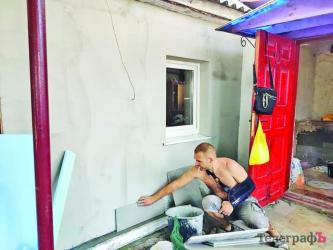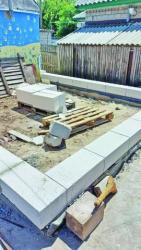Боєць із Кременчука Василь Онищенко за підтримки читачів видання «Телеграф» добудовує будинок однією рукою
Боєць і батько трьох чудових донечок Василь Онищенко після повернення з війни однією рукою будує будинок. На початку весни 2014 року чоловік із дружиною планували розширити своє помешкання, тож готували місце під фундамент, але війна з Росією внесла свої корективи.
Василь спочатку служив у батальйоні «Айдар» біля кримського півострова, згодом воював у Дебальцевому в складі 128-ї бригади. Чоловік тричі був поранений. Втретє отримав поранення в тому місці, яке вже було пошкоджене. Нині в нього немає частини кістки ключиці. Попри нестерпний біль та незручності Василь самотужки будує будинок однією рукою.
Чоловік зранку відводить доньок до школи, п’є знеболювальні та добудовує оселю. Кременчужанин самотужки утеплював будинок минулого року.
За підтримки читачів видання «Телеграф» вдалося утеплити помешкання, добудувати кухню, а зараз триває будівництво другого поверху.
— Кухня залишиться, а тут буде вхід для дівчат. Це буде їхня територія з другим поверхом. А ми з дружиною залишимося на тій половині, — Василь показує на кімнату, де вони зараз усі разом мешкають. — Дівчата самі вирішуватимуть, як облаштувати свої кімнати. Велика подяка за допомогу кременчужанам, а також Миколі Корецькому, який допоміг грошима та з робочими (вони допомогли з дахом).
За останні три роки Василь утеплив будинок, добудував літню кухню й зараз добудовує перший та частково другий поверхи.







Додати новий коментар
Everettalafe
11.07 2025 - 8:18
Посилання
Today was supposed to be the
Jameshex
11.07 2025 - 8:24
Посилання
Unity and BrightBuilt factory
NathanRap
11.07 2025 - 10:24
Посилання
High costs are still a big
MichaelLargo
17.07 2025 - 22:23
Посилання
Строительство домов — это
Walterdib
24.07 2025 - 23:23
Посилання
<p dir="ltr">В Приморском
CoreyPauts
25.07 2025 - 3:17
Посилання
Indian and Chinese travelers
RichardSlubs
27.07 2025 - 9:24
Посилання
Введение в bs2best at ссылка
Clintonlacle
27.07 2025 - 19:30
Посилання
Unity and BrightBuilt factory
DanielNaike
28.07 2025 - 9:07
Посилання
It all started back in March,
ScottMom
28.07 2025 - 14:26
Посилання
What struck Scott Bennett
Keithmaype
28.07 2025 - 14:43
Посилання
It all started back in March,
Richardcon
28.07 2025 - 17:27
Посилання
It all started back in March,
AnthonyHeicy
29.07 2025 - 1:54
Посилання
What struck Scott Bennett
bk8-779
30.07 2025 - 16:49
Посилання
Follow <a href=https://www
pusulabet-602
1.08 2025 - 15:39
Посилання
Sadece <a href=https://www
pusulabet-484
1.08 2025 - 20:52
Посилання
Bu, <a href=https://www
188bet-80
2.08 2025 - 12:26
Посилання
Tham gia d? theo doi cac
789bet-257
2.08 2025 - 13:46
Посилання
Kham pha n?i dung d?c quy?n
hi88-931
2.08 2025 - 15:41
Посилання
Day la ngu?n thong tin chinh
shbet-977
2.08 2025 - 16:59
Посилання
Ch? nhom <a href=https://www
f8bet-541
2.08 2025 - 18:24
Посилання
Day la nhom duy nh?t du?c xac
new88-735
2.08 2025 - 20:10
Посилання
Tham gia nhom <a href=https:/
33win-825
2.08 2025 - 22:03
Посилання
G?p g? ngu?i dung th?t va th
bk8-502
2.08 2025 - 23:44
Посилання
Tham gia nhom <a href=https:/
kubet-411
3.08 2025 - 1:39
Посилання
Ch? co trong nhom Facebook <a
plinko-429
3.08 2025 - 11:12
Посилання
Looking for the real <a href
tigrinhoRit
3.08 2025 - 13:19
Посилання
Nao caia em sites falsos —
tigrinhoRit
3.08 2025 - 16:21
Посилання
Jogue com seguranca acessando
tigrinhoRit
3.08 2025 - 17:58
Посилання
Participe da comunidade real
tigrinhoRit
3.08 2025 - 19:43
Посилання
Explore conteudos confiaveis
tigrinhoRit
3.08 2025 - 21:26
Посилання
Receba noticias e bonus do <a
tigrinhoRit
3.08 2025 - 22:50
Посилання
Somente no <a href=https:/
tigrinhoRit
4.08 2025 - 0:15
Посилання
Evite sites falsos – acesse o
tigrinhoRit
4.08 2025 - 1:34
Посилання
Encontre as informacoes
tigrinhoRit
4.08 2025 - 9:39
Посилання
Entre agora no verdadeiro <a
tigrinhoRit
4.08 2025 - 17:33
Посилання
O <a href=https://tigrinho-2
tigrinhoRit
4.08 2025 - 19:51
Посилання
Tudo sobre <a href=https:/
tigrinhoRit
4.08 2025 - 22:19
Посилання
Participe da comunidade do <a
tigrinhoRit
4.08 2025 - 23:43
Посилання
Aproveite ofertas exclusivas
tigrinho-516
5.08 2025 - 17:45
Посилання
Entre no <a href=https:/
tigrinho-476
5.08 2025 - 19:17
Посилання
Experimente o <a href=https:/
tigrinho-253
6.08 2025 - 2:11
Посилання
Acesse <a href=https:/
tigrinho-88
6.08 2025 - 3:32
Посилання
Acesse o site oficial do <a
tigrinho-34
7.08 2025 - 11:38
Посилання
O verdadeiro <a href=https:/
tigrinho-795
7.08 2025 - 13:00
Посилання
Jogue com confianca atraves
tigrinho-958
7.08 2025 - 16:32
Посилання
Ganhe jogando o <a href=https
WalterFoell
8.08 2025 - 5:05
Посилання
Я привык планировать финансы,
tigrinho-348
8.08 2025 - 12:37
Посилання
Jogue agora no <a href="https
tigrinho-309
8.08 2025 - 14:08
Посилання
Participe do verdadeiro <a
MichaelGak
12.08 2025 - 15:50
Посилання
Ich bin schon lange im
Сторінки